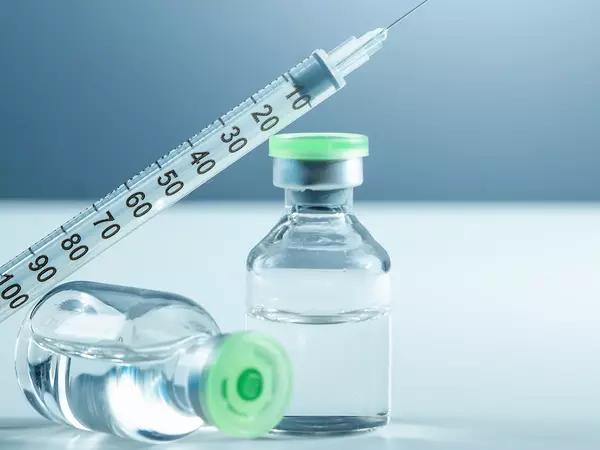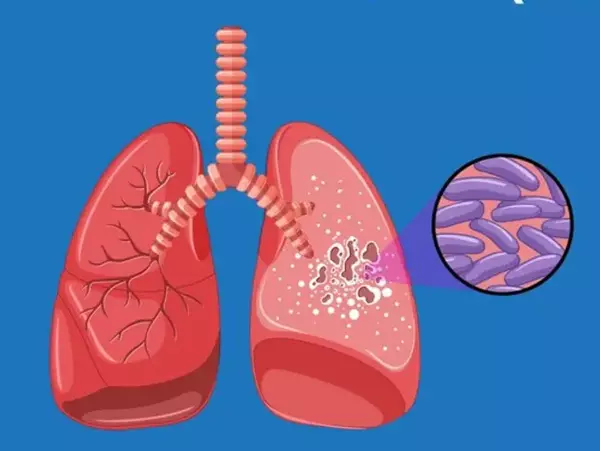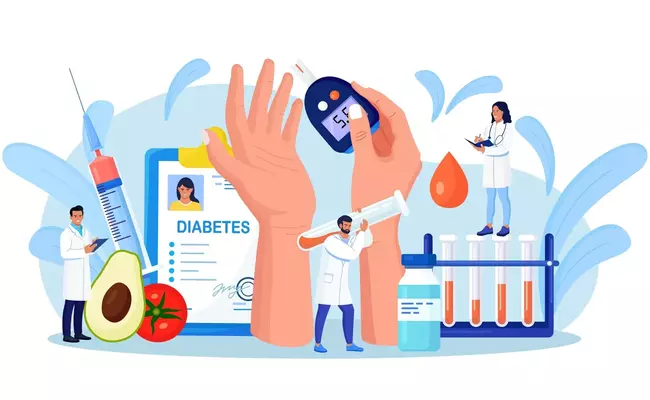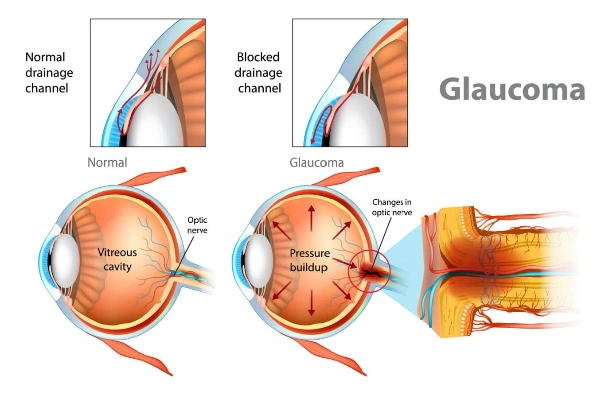INSR Gene Insulin Receptor

If you tested your DNA with a personal genomics service like 23andMe, AncestryDNA, FamilyTreeDNA, MyHeritage or another testing company, you can learn more about your risk factors for hundreds of diseases. By clicking the button above ⬆️, you can upload your raw DNA data file and receive a personalized 250-page health report with research links that is the most comprehensive.
The gene known as INSR directs the production of insulin receptors - proteins present in various cell types. Insulin receptors attach to circulating hormones in the bloodstream and are anchored within cells' outer membranes. Vital for regulating blood glucose levels, insulin controls how much glucose is transferred from the bloodstream into energy-producing cells throughout our bodies.
Initially, the insulin receptor is synthesized as a lengthy protein that necessitates cleavage into four fragments: two alpha subunits and two beta subunits. These combined units constitute an operational receptor wherein the surface of the cell features protruding alpha components while its interior houses beta elements. Insulin links (binds) to these projecting alpha parts, thereby causing signaling pathways inculcated by adjoining beta constituents which sporadically impact various cellular functions.
The insulin receptor's primary action is to initiate glucose absorption. Consequently, a decrease in the signaling of this receptor - also known as "insulin insensitivity" - results in an inability for cells to properly uptake glucose leading to type 2 diabetes mellitus. The consequence includes increased circulating levels of blood sugar or hyperglycemia and all associated conditions related with diabetes.
Acanthosis nigricans may be exhibited by patients who have insulin resistance.
Several cases of homozygous mutations in the INSR gene have been observed, leading to either Donohue syndrome or Leprechaunism. This particular disorder, which follows autosomal recessive inheritance patterns, hinders insulin receptors entirely. Its patients exhibit an array of symptoms such as ears that are low-set and often prominent; flared nostrils; thickened lips; and severe growth stunting. Unfortunately for most diagnosed with this condition, their prognosis is bleak due to death occurring within one year after birth. In contrast,Rabson-Mendenhall syndrome caused by other mutations on the same gene results in less critical effects including abnormal teeth shape characteristic formation of enlarged pineal glands following hypertrophic tissue development around gums (gingiva). Both diseases share a hallmark glucose level fluctuation response pattern: right after taking meals enough elevations occur only to be followed shortly afterwards possibly critically low blood sugar levels.[21] There also exists Severe Insulin Resistance from genetic anomalies affecting different parts of insulin receptor genes altogether.
Follow the link of the selected polymorphism to read a brief description of how the selected polymorphism affects Insulin and see a list of existing studies.
SNP polymorphisms related to the topic Insulin:
| rs1799999 | Widespread amino acid polymorphism is associated with insulin resistance and insulin hypersecretion. |
| rs1169288 | Variation in the HNF1A gene region affects CRP levels. The association between the common variant of the HNF1A gene p.I27L (rs1169288) and the risk of developing type 2 diabetes mellitus is weight-dependent. |
| rs7903146 | This is one of two SNPs in the TCF7L2 gene that have been reported to be strongly associated with type 2 diabetes, the other being rs4506565. They have approximately equal power to assess the risk of developing type 2 diabetes , and the results of one test correlate with the other in 92% of cases. Associated with reduced insulin secretion, as measured by the acute response to insulin and increased rate of glucose production in the liver. |
| rs13266634 | The zinc transporter gene SLC30A8 polymorphism is associated with type 2 diabetes. |
| rs7754840 | The single nucleotide polymorphism rs7754840 of CDKAL1 is associated with impaired insulin secretion and proinsulin conversion. |
| rs2059807 | The insulin receptor variant is associated with insulin resistance and polycystic ovary syndrome. |
| rs1801278 | The Gly972-->Arg amino acid polymorphism in IRS-1 impairs insulin secretion in pancreatic beta cells. It also causes impaired insulin signalling and affects glucose metabolism in skeletal muscle cells. |
| rs780094 | The GCKR rs780094 polymorphism is associated with increased fasting serum triacylglycerol, decreased fasting insulinaemia and reduced risk of type 2 diabetes. A diet restricting carbohydrates and increasing protein is particularly effective for carriers of the T risk allele. |
| rs12255372 | Polymorphisms in the transcription factor 7-like 2 (TCF7L2) gene are associated with a significant increase in the risk of type 2 diabetes. |
| rs1887922 | Polymorphisms in the insulin-degrading enzyme (IDE) gene determine insulin metabolism and the risk of developing type 2 diabetes. It also affects a person's life expectancy. |
| rs1801282 | Peroxisome proliferator-activated receptor gamma gene variation on the progression of type 2 diabetes and obesity. Also higher risk of cardiovascular disease with a diet high in saturated fat. |
| rs2229765 | Insulin-like growth factor 1 (IGF-1) receptor polymorphic variant correlates with male longevity. |
| rs7202877 | Increased risk of islet autoimmunity and type 1 diabetes. |
| rs1111875 | HHEX gene polymorphism is associated with impaired proinsulin conversion and increased risk of developing type 2 diabetes. |
| rs2295490 | Growing role of TRIB3 as a gene affecting human insulin resistance on glucose homeostasis by altering the interaction between insulin sensitivity and secretion. |
| rs4607103 | Genetic predisposition to long-term non-diabetic disorders of glucose homeostasis. |
| rs6220 | Genetic polymorphisms involved in the insulin-like growth factor (IGF) pathway regulate mammographic breast density ratio. |
| rs9787485 | Determinants of B-cell function and fasting glycaemic trajectories in childhood. |
| rs10830963 | common variant MTNR1B, which encodes melatonin receptor 1B, increases the risk of impaired fasting glycaemia and type 2 diabetes due to impaired glucose-stimulated insulin release. The findings suggest that carriers of the G allele rs10830963 may have greater improvement in obesity and body fat distribution when following a low-fat diet. |
| rs1044498 | A polymorphism (K121Q) of the region encoding human glycoprotein PC-1 is closely associated with insulin resistance. |
| rs689 | A break in the INS insulin gene associated with the occurrence of type 1 and type 2 diabetes. |
| rs30360 | |
| rs484659 | |
| rs487894 | |
| rs634264 | |
| rs816200 | |
| rs891088 | |
| rs1004361 | |
| rs1400589 | |
| rs1501635 | |
| rs1517204 | |
| rs4304868 | |
| rs4492895 | |
| rs4698790 | |
| rs7254487 | |
| rs7254921 | |
| rs7255710 | |
| rs7342408 | |
| rs7964607 | |
| rs7976621 | |
| rs7977174 | |
| rs10431397 | |
| rs10744901 | |
| rs10774926 | |
| rs12425296 | |
| rs16891077 | |
| rs17619048 | |
About The Author
Li DaliLi Dali, a National Foundation for Outstanding Youth Fund recipient, is a researcher at the School of Life Sciences in East China Normal University. He earned his PhD in genetics from Hunan Normal University in 2007 and conducted collaborative research at Texas A&M University during his doctoral studies. Li Dali and his team have optimized and innovated gene editing technology, leading to the establishment of a world-class system for constructing gene editing disease models.


